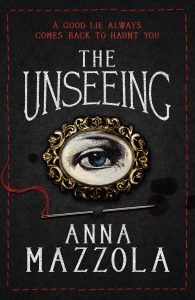Deception, Lies, Murder & Mystery: Anna Mazzola’s The Unseeing
Charlotte Wightwick
 Anna Mazzola’s atmospheric debut novel, The Unseeing (Tinder, 2016 / Sourcebooks Landmark, 2017), is a dazzling blend of fact and fiction, truth and deception, as befits the subject matter – the horrific murder of Hannah Brown and its aftermath in nineteenth-century London. She discusses Sarah Gale and how she went about crafting her beautiful and disturbing story.
Anna Mazzola’s atmospheric debut novel, The Unseeing (Tinder, 2016 / Sourcebooks Landmark, 2017), is a dazzling blend of fact and fiction, truth and deception, as befits the subject matter – the horrific murder of Hannah Brown and its aftermath in nineteenth-century London. She discusses Sarah Gale and how she went about crafting her beautiful and disturbing story.
In 1837, London was transfixed with horror by what became known as the ‘Edgware Road murder’ – so-called because the victim’s dismembered body was found in that location. James Greenacre was sentenced for the murder of his fiancée, and his mistress, Sarah Gale, was sentenced for helping him. The Unseeing follows Gale’s story after her conviction. When asked what drew her to Sarah, Mazzola says:
“It was [her] silence that drew me in. The newspaper reports from the time noted that she remained quiet and motionless throughout her trial… Sarah’s barrister…said very little to counter the allegations that Sarah Gale must have known that James Greenacre, her lover, had killed and dismembered the victim in the house in which they lived. That got me thinking: what was really going on? Was Sarah Gale afraid of Greenacre? Was she guilty? Or was it something else entirely?”
It is this central ambiguity which makes the novel so fascinating. Mazzola has painted a compelling picture of a woman driven to protect – something, someone – in the only way she can: by her silence. She is an intriguing, enigmatic central character, off-set by the naïve young barrister (Edmund Fleetwood), haunted by his own demons, who is asked to review her case. All of the characters carry secrets, deceiving others or themselves. The author says of this leitmotif:
“I think that came partly from the real case (the defendants were evidently lying in order to protect themselves or others) and partly from the way I investigated the materials. I myself was trying to get to the ‘truth’ of what had happened – past the false stories created by the newspapermen and the numerous accounts said to have been penned by Greenacre – but I was also warping the truth in order to write my own story. And of course that story was a mystery, in which the reader is also trying to get to the truth, so truth and deception became a key theme.”
Indeed, truth and lies are no strangers to Mazzola, whose background as a criminal lawyer helped shape her approach:
“I didn’t think of it at the time, but I suppose it was my interest in criminal justice that attracted [me] to this particular story – of a woman who had clearly been silenced in some way. It must also have shaped the plot, as justice and injustice are at its heart.”
It is not initially clear whether it is justice for Sarah, or for the victim, that is the central plank of the plot. We know that Sarah is not telling the whole truth, but as we discover more about her, we are led to feeling increasingly sorry for her, helped by Edmund’s evident compassion and the parallels between Sarah’s life and his own mother’s, both affected by domestic abuse. When asked how she approached such a difficult topic, Mazzola says:
“In some ways, things were very different… It was widely accepted that men of all classes would beat their wives and children, and it was rare for anything to come of it. However, in some respects, we haven’t come that far: many victims of domestic and sexual abuse are afraid to speak out, and many are failed by the justice system. The shame, the anger and the fear are still there.”
Yet Mazzola’s skill as an author is such that, even as we know Sarah is, on many levels, a victim, it remains clear that she is lying to protect someone, although the identity of that someone remains a mystery until the end of the novel. It makes for a tense, gripping and highly enjoyable read – and one whose themes continue to resonate today.
About the contributor: Charlotte Wightwick is a writer and reviewer for the HNS. Her first novel, The Lady with an Ermine, is based on Leonardo da Vinci’s portrait of the same name and is set in Renaissance Milan.
______________________________________________
Published in Historical Novels Review | Issue 77, August 2016






